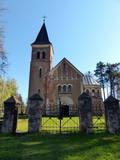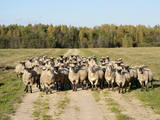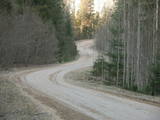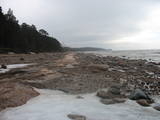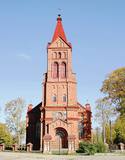| Nr | Name | Beschreibung |
|---|---|---|
|
Das Denkmal befindet sich am Rand der Rigas Straße, gegenüber dem Schloss von Krustpils. Das im Jahr 1925 enthüllte und im Jahr 1992 erneuerte Denkmal (Architekt Aleksandrs Birzenieks) ist zum Gedenken an die Einwohner von Krustpils gebildet worden, die in den Freiheitskämpfen von Lettland gefallen sind. Von dem Denkmal bietet sich eine schöne Aussicht auf den Fluss Mazā Daugava und auf die Inseln Daugavsala und Ādamsona saliņa (oder Krustpils saliņa). |
||
|
Auf dem Bauernhof Epi auf der Insel Saaremaa werden Obst- und Beeren-Ketchups produziert, verschiedene Marmeladen hergestellt, Gewürzkräuter und Tees angebaut. Die Produkte werden nur aus lokalen Rohstoffen der Inseln Saaremaa und Muhu hergestellt. Die Produkte kann man direkt im Bauernhof kaufen. |
||
|
Atrodas 0,3 km ziemeļos no Vecpiebalgas pilsdrupām. Ap 10 m augsto, bet visnotaļ izteiksmīgo Grišku kalnu sauc arī par Piebalgas, Balgas un Veļķu pilskalnu. 13. gs. šeit bijusi svarīga apmetnes vieta ar mākslīgi nostāvinātām nogāzēm un dziļu aizsarggrāvi. Vēstures notikumi ir atstājuši ap metru biezu kultūrslāni. Bezlapu laikā no kalna paveras skats uz Vecpiebalgas baznīcu un pilsdrupu vietu. Pilskalna piekājē ir aka ar Griškavotu. |
||
|
Die heutige – die dritte – Kirche wurde im Jahr 1906 auf der Initiative und aus der zur Verfügung gestellten Finanzierung von Gotthard von Budberg gebaut. Er hat das Gotteshaus seiner verstorbenen Frau Gertrude Vorsa gewidmet. In der Kirche ist eine Orgel der Firma Walker aufgestellt, die im Jahr 1906 in Ludwigsburg (in Süddeutschland) hergestellt worden ist. Im Jahr 1992 wurde in der Kirche eine Gedenktafel an die repressierten Einwohner von Gārsene enthüllt. Auf dem Friedhof, der sich 100 Meter südlich von der Kirche befindet, kann man die mit Erzählungen umwobene Gruft der Baron-Familie Budberg und nebenan auch den Friedhof der Familie besichtigen. Die Kirche kann man auch von innen besichtigen. |
||
|
This reserve was set up to protect local swamps and surrounding wetlands. Please note that before you can visit the reserve, you must register with the local administration and visitor centre in the village of Tooma.
|
||
|
Regīna Kalniņa is one of the best known craftswomen in Kurzeme. She weaves blankets and shawls and knits colourful mittens. She also sews Rucava and Nīca folk costumes. The process of weaving and knitting can be viewed. Regīna’s products are widely demanded in Latvia and in other European countries. |
||
|
Die Ordenfestung Vasteliina stammt aus dem 14. Jh. Und bis zum Ende des 17. Jh. war es eine mächtige Grenzfestung zwischen Russland und Europa. Endgültig wurde die Festung im Nordischen Krieg 1702 zerstört. Im Mittelalter war die Festung von Vastseliina in der katholischen Welt als Zielort von Pilgerwanderungen bekannt. Das Besucherzentrum befindet sich im ehemaligen Wirtshaus. Für die Gäste werden Ausstellungen über Geschichte der Burg und der Ortschaft, Legenden, Handarbeit, Workshops, Konzerte und Spektakel angeboten. Im ehemaligen Wirtshaus werden stilvolle Mahlzeiten durchgeführt, wo die Gäste Kleidung aus Mittelalter tragen. |
||
|
Auf den umliegenden Feldern der Wirtschaft, die in dem Dienerhaus des ehemaligen Landgutes von Ķempēni haust, weiden mehr als 200 Lettische Schwarzköpfige Schafe (diese Rasse wurde in Lettland in den 1920er bis 1930er Jahren gezüchtet). Hier kann man Fleisch, Wolle und Felle kaufen, sowie an einer Führung mit Verkostung teilnehmen. |
||
|
Dieses Gebiet ist kleiner als die Großen Kangari – Berge, ungefähr 10 km lang und 16 m hoch. Es befindet in der Nähe des Buļļi – Sumpfes. Das Territorium soll die Struktur, den Sumpf und die verschiedenen Waldarten und seltenen Pflanzen, die es in diesem Gebiet gibt, schützen.
|
||
|
A friendly place for families, children and all interested parties. You can go on a tour or individually look at and learn about marmosets. |
||
|
The trail tells about grey dunes which have survived thanks to the border restrictions and the presence of military. The trail starts from the parking place at the mouth of the Užava river. It is one of the few natural rivermouths in Europe. One can also see the „tacis”, an industrial installation for lamprey (Lampetra fluviatilis) fishing during their spawning migration period. The 3km long trail is circular. It winds for 1.5km from the Užava rivermouth to the North, along the coastline (the beach is covered with sand and pebbles), and returns to the starting point by a gravel road through grey dunes. Along the trail, one can observe a distinct white dune with rare plant species Linaria loeselii, Lathyrus maritimus, Anthyllis arenaria, Tragopogon heterospermus. About 1km from the rivermouth, in the sea, one can see a wrack of a sailing ship (parts of frame). The visibility depends on the flow of sand in the sea. The way back opens a beautiful view of the range of grey dunes. Unfortunately, Scots Pine starts taking over the area. There are three important biotopes of EU significance: „Fixed dunes with herbaceous vegetation 2130”, „Decalcified fixed dunes with Empetrum nigrum 2140” and „Dunes with Salix arenaria 2170”, forming a unique mosaic. Typical species here: mountain Alison ‘(Alyssum gmelinii), Pasqueflower (Pulsatilla pratensis), Sand Pink (Dianthus arenarius), Rosemary Leaved Willow (Salix rosmarinifolia), Dark Red Helleborine (Epipactis atrorubens), Kinnikinnick (Arctostaphylus uva-ursi). As a former military site, some military constructions can be seen here like horseshoe-shaped sand ramparts by the road in gray dunes. They were built to disguise military vehicles in case of sea attack. By the Kangroti graveyard, towards the Užava river, there is an underground pillbox. It is a one-man fortification to fire along the coastal perimeter. The Mouth of River Užava walking route is in the nature reserve „Užava” |
||
|
This is one of the few workshops in Latvia where things are woven with birch bark. You can look at the objects and discuss the experience of the craftspeople. They will help you to produce simple objects out of birch bark, and those will be excellent souvenirs. |
||
|
The Neļķes cliffs are in Skaņākalns Park, and they offer the most beautiful view of the Salaka River valley, with its sandstone cliffs and peaceful river. There are good views from the “devil’s pulpit.” It’s worth visiting the Skaņamkalns Hill to check out the views from the famous echo cliff. This is part of the ZBR.
|
||
|
Since ancient times bread has been our staple food, and formed part of breakfast, lunch and our evening meal. We bake bread from rye, wheat, buckwheat and barley. Both fine-ground and wholemeal flour is used. Bread baking is one of the most honoured traditional skills in Latvia. Caunītes country house keeps Latvian traditions alive and demonstrates them to visitors. The house is designed and decorated in the traditional Latvian style and exudes an authentic ambience while having modern facilities. Under the guidance of the hostess, visitors will bake their own loaf of sweet-and-sour bread in a wood-fired bread oven. In Latvian families it was traditionally one of the main duties of the lady of the house to bake a week’s supply of bread for the whole family every Saturday morning. Every woman was proud of her own unique recipe and passed it down to her daughters and granddaughters through the generations. There are many traditional beliefs, sayings and riddles linked with bread in Latvian folklore. Today, there is great interest in the old recipes, bread-baking methods and the use of organic ingredients as many families are opting for a healthy lifestyle. |
||
|
Es ist eines der seltenen Angebote in der Region Latgale, wo der Reiseleiter während der Führung in der lettgallischen Mundart singt. Es ist eine fesselnde und attraktive Erzählung über historische Ereignisse, die mit dem Landgut von Preiļi und mit dieser Stadt verbunden sind. |
||
|
Das offene Meer im Westen von Tūja ist ein wichtiges Gebiet zum Schutz der Zwergmöwe während der Frühlingsmigration. Das Territorium befindet sich gegenüber der Regionen Salacgrīva, Limbaži, Saulkrasti und Carnikava. Die Fläche beträgt 58 600 ha.
|
||
|
The farm grows apples, pears and medicinal plants such as peppermint, marigold, etc. The owners also collect wild medicinal plants. An interesting tour is available, and you can purchase products at the farm or at the Latvian Eco Product Store at Barona Street 45-47 in Rīga. |
||
|
St. John the Baptist Roman Catholic Church of Ciskādi was built approximately in 1990. The brick building is an example of Romanesque style.
The church has a specific icon called „Madonna and the child”, crucifix and the
organ.
|
||
|
Etwa eine Autostunde von Riga entfernt, auf dem Gelände des alten Landguts Anna befindet sich das international renommierte Designhotel Annas Hotel. Inspiriert von alten Traditionen der lettischen Küche kreiert der Küchenchef jeden Tag ein neues Menü und lässt die Gäste immer eine besondere und ungewöhnliche Mahlzeit genießen. Lettische Küche: Brühe mit Pfifferlingen, Speisen aus Kaninchenfleisch. Das besondere Gericht: Suppe aus Heidelbeercreme mit Eis aus Quark. |
||
|
Divarpus kilometrus gara taka (vienā virzienā) aizved līdz Hallistes palieņu pļavām, kur Hallistes upes labajā krastā ir uzcelts divstāvīgs koka skatu tornis. No tā paveras visaptverošs skats uz atjaunotajām (izcirsti krūmi) Hallistes palieņu pļavām. Pavasara palu laikā no torņa redzamā apkārtne un tornis atrodas ūdenī. |
||




